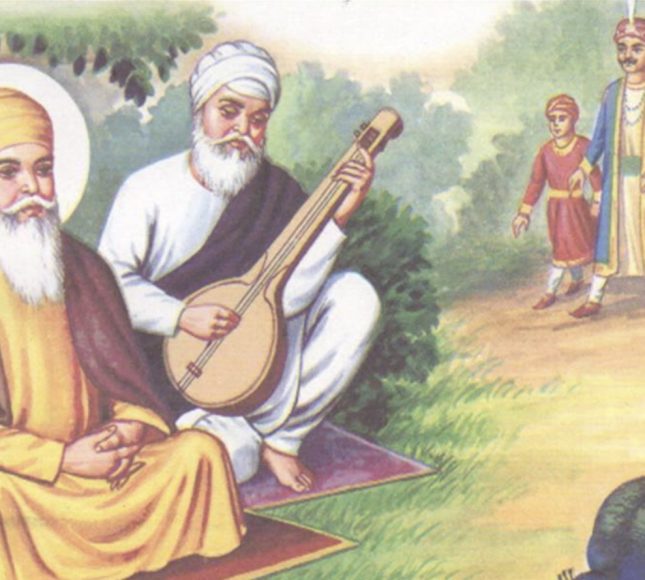SHIVNABH, RAJA, was, according to the Janam Sakhi tradition, a Ceylonese king who became a devotee of Guru Nanak. It was a merchant of Lahore, Bhai Mansukh, who during a visit to Ceylon, then known as Sinhaldvip, had impressed the king with his conduct as well as with the account of what he described as his perfect Guru, Nanak. Shivnabh became interested in Guru Nanak and was anxious to see him. But Mansukh advised him to meditate on the Guru and wait for him in Ceylon itself. Since then the Raja had awaited the Guru`s coming. Guru Nanak travelled to the far of “Singhal dip” (Sinhaldvip, the island of the Sinhalese) accompanied according to Puratan Janam Sakhi by two disciples, Saido and Siho.
Raja Shivnabh along with his wife Chandrakala, and their 12year old son, entered the path of discipleship. So did some of the populace. At the Guru`s instance, Shivnabh established a dharamsala where the faithful assembled by night to pray and recite hymns in praise of God. While in Ceylon, relates the Puratan Janam Sakhi, Guru Nanak was inspired to utter Pran Sangli, a metrical composition of twenty-one stanzas describing the state of true religious discernment. A written script was made by Saido and left with Raja Shivnabh.
When Guru Arjan (1563-1606) began to collect the sayings of his predecessors for inclusion in the Scripture, a Sikh by the name of Bhai Paira was sent to Ceylon in search of this composition.The copy that he brought was not regarded as genuine by the Guru and was thus excluded from the sacred volume he was compiling. It was however included in Bhai Banno`s copy of the Scripture as Haqiqat Rah Maqam Shivnabh Raje Ki, which is considered by the Sikhs as an apocryphal composition.
References :
1. Vir Singh, Bhai, ed., Puratan Janam Sakhi. Amritsar, 1971
2. Santokh Singh, Bhai, Sri Gur Pratap Suraj Granth. Amritsar, 1927-35
3. Kirpal Singh,Janam Sakhi Parampara. Patiala, 1969
4. Macauliffe, M.A., The Sikh Religion, Oxford, 1909
5. Harbans Singh, Guru Nanak and Origins of the Sikh Faith. Bombay, 1969
Raja Shivnabh occupies a fascinating niche in the expansive narrative of Guru Nanak’s influence—a story that stretches far beyond the Punjab and into the ancient island of Ceylon (modern-day Sri Lanka). According to the Puratan Janam Sakhi tradition, Raja Shivnabh was a Ceylonese king whose transformation began when a merchant from Lahore named Bhai Mansukh recounted to him the transcendent qualities and divine grace of Guru Nanak. Deeply moved by this testimony, the Raja, along with his wife Chandrakala and their young son, embraced a life of devotional discipline, patiently awaiting the arrival of the revered Guru in his realm.
True to the promise of faith and devotion, Guru Nanak eventually made his way to Ceylon, accompanied by his loyal disciples Saido and Siho. Upon his arrival, Raja Shivnabh’s long-held yearning was fulfilled, leading him to establish a dharamsala—a sanctuary where devotees gathered at night to pray, recite hymns, and experience the spiritual ambiance fostered by Guru Nanak’s presence. During his sojourn in this sacred setting, Guru Nanak is said to have composed the metrical work “Pran Sangli,” a verse of twenty-one stanzas extolling true religious discernment. Recorded by Saido and left with the Raja, this composition later became the subject of scrutiny when Guru Arjan compiled the Sikh scripture; a version retrieved from Ceylon was ultimately deemed apocryphal, surfacing in some copies as “Haqiqat Rah Maqam Shivnabh Raje Ki”.
Guru Nanak Dev Ji visited Ceylon, where he took his seat in Raja Shivnabh’s garden.
At that time it was barren, but it is said to have become green on the Guru’s arrival. The gardener requested the king to go and see the faqir who had caused the withered garden to bloom anew. The king sent beautiful damsels to dance before the Guru and tempt him with their charms. The Guru, wrapped up in his own thoughts, neither spoke to them nor noticed them.
The king came and inquired his name, caste, and whether he was a Jogi. The Guru replied as follows:-
The Jogi who is associated with the Name and is pure, has not a particle of uncleanness. He who keeps with him the name of the Beloved, which is ever true, has escaped birth and death.
The king asked if he were a Brahman. The Guru replied:–
He is a Brahman who has divine knowledge for his ablutions, and God’s praises for the leaves’ of his worship. There is but One Name, One God, One Light in the three worlds.
The king asked if he were a shopkeeper. The Guru replied:–
Make your heart the scale, your tongue the beam, and weigh the inestimable Name. There is but one shop, one Merchant above all; the dealers are many.
The king again inquired if he were a Hindu or a Muhammadan. The Guru continued his enigmatical replies:–
The True Guru has solvef the problem of the two ways. It is he who fixes attention on the One God, and whose mind wavers not, who can understand it. He who abides in the Word and ever worships day and night, has ended his doubts.
The king then asked if he were Gorakhnath. The Guru showed no inclination to directly gratify his curiosity.
Above us is the sky, Gorakh is above the sky; His inaccessible form dwells there; By the favour of the Guru, whether I am abroad or at home is the same to me; Nanak has become such an anchoret.
When the Guru had ended, the king invited him to go to his palace and see his queen. He gave him an opportunity of expounding his doctrines to her.



